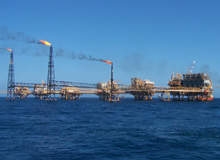
The past decade of the offshore industry has been characterised by the march of the industry towards deepwater in search of undiscovered oil and gas resources. Some of the most promising discoveries have taken place in offshore regions of the Gulf of Mexico, Brazil, India, Angola, Australia and China. While the Gulf of Mexico is a mature province, other regions are frontier markets with promising geology.
A new report by Global Markets Direct Global Data Offshore Trends and Analysis reveals just how important these offshore sites are to the energy industry and global politics.
In particular, the Gulf of Mexico is important for energy security in the US. Most of the resources in the shallow-water region have been discovered and produced, leaving the deepwater region as the location where most activities are taking place. As a consequence, production from deepwater is primarily responsible for arresting the decline in production from shallow-water regions. Most of the international companies with a presence in the region are operating in the offshore areas and have discovered significant reserves.
More than 2,000 exploration wells were drilled between 2000 to 2007, resulting in the discovery of 70 fields. Nearly a quarter of those were in areas deeper than 1,000ft. In addition, reserve estimates for recent field discoveries may have significant upsides because of increased use of advanced technologies such as well control, reservoir management and in-field exploration.
Down the coast
Offshore Brazil has had some equally promising discoveries, making it self sufficient in crude oil and securing the nation’s energy security. The Santos and Campos basins have been home to most of the discoveries that have propelled Brazil-based Petrobras to the top of the league of oil and gas producing companies.
How well do you really know your competitors?
Access the most comprehensive Company Profiles on the market, powered by GlobalData. Save hours of research. Gain competitive edge.

Thank you!
Your download email will arrive shortly
Not ready to buy yet? Download a free sample
We are confident about the unique quality of our Company Profiles. However, we want you to make the most beneficial decision for your business, so we offer a free sample that you can download by submitting the below form
By GlobalDataBrazil has had nine licensing rounds since 1998, providing international companies with a level playing field for bidding in exploration blocks. But in the case of the multi-billion barrel fields of Tupi and Carioca, the regulator removed the blocks in these pre-salt basins, ensuring national dominance. Big players in the country’s oil and gas industry were sidelined by this decision and consequently those such as Shell and Chevron made no bids after the government pulled these most promising blocks.
Between 1998 and 2006 a total of 681 exploratory wells were drilled by the now domestic-giant Petrobras at a success rate of 31% and Global Markets Direct estimates that there are ten major projects, which will add a million barrels of production a day before 2012. Most of these are located in the high-potential basins of Campos, Santos and Espirito Santo.
Indian assets
In the past seven years there have been six licensing rounds in India, carried out in the hope of providing a level playing field for private and international companies to bid for exploration blocks in the country. During these, many international companies such as Geopetrol, Cairn Energy, British Gas and Niko Resources have entered the Indian marketplace.
In six rounds of bidding, production sharing contracts (PSC) have been signed for 162 blocks, whereas in the pre-New Exploration Licensing Policy regime only 28 PSC blocks were signed.
Between 2000 and 2007, India’s national oil companies – ONGC and OIL – made 49 hydrocarbon discoveries of which 15 are in offshore and 34 are in onshore areas. Out of 15 offshore discoveries, nine were made in the Kutch and Mumbai basins in the western regions while the remainder were located in the KG basin, off its east coast. All were made by ONGC.
During the same period, private domestic and international companies have made 64 discoveries in five major basins; Krishna-Godavari, Mahanadi, Gulf of Cambay, Rajasthan and Campay. Out of these it is the Krishna-Godavari basin that has witnessed the highest number of discoveries and is subsequently the most coveted basin during any licensing rounds.
Ones to watch
Angola is one of the few countries in the world where the reserve additions have been on average greater than a billion barrels a year and more than double the volume produced. The government has encouraged the participation of international oil companies by revising hydrocarbon laws, opening acreages and being flexible in cooperation. Driven by the need for oil revenue, fiscal terms in Angola are among the most favoured for operators and it is one of the few countries where leases are awarded on the basis of discovered fields.
A total of 155 exploration and appraisal wells have been drilled since 2000 and although the cost per well is high – on average about $20m – the success rate at 80% is impressive and can mitigate the initial high-risk that is perceived. Based on the current exploration plans, 142 further wells are expected to be drilled before 2012.
Meanwhile, Australia has had significant discoveries in the north-west shelf area and most of these are being tied into LNG production. With demand continuously rising from Asia Pacific, it is the opportunity presented by LNG exports that has spurred the offshore exploration in Australia.
In China, meanwhile, there have been a number of recent large discoveries traditionally in the Bohai Bay, Yellow Sea, East China Sea and the northern continental shelf of the South China Sea. It is estimated that these basins have a combine resource of more than 100 billion barrels of crude oil, providing crucial energy to China’s ever-growing population.
For more Global Markets Direct reports, visit the report store at www.global-markets-direct.net







